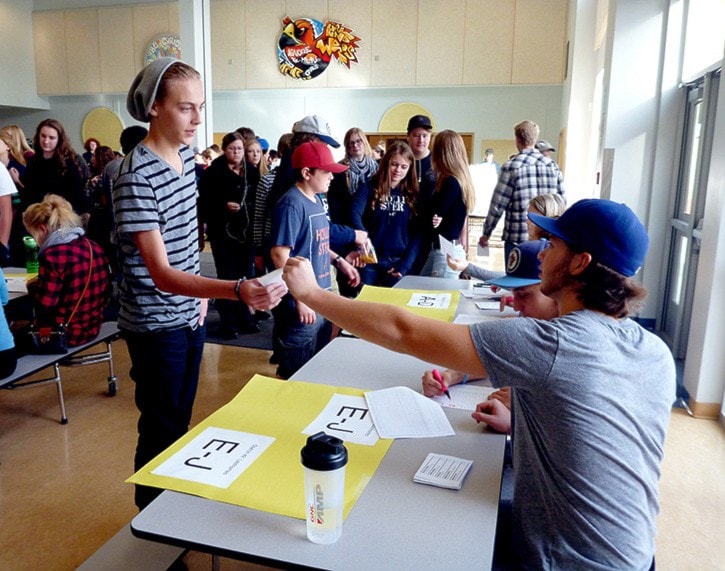Much like their parents, students at J. L. Crowe Secondary School favoured the New Democratic Party, if a recent mock vote is any indication.
Grade 12 students have tallied results that found 36 per cent of the high school's student population choose NDP's Richard Cannings.
That fell in line with the approximate 37 per cent of votes cast in favour of the NDP candidate in the Southern Okanagan-West Kootenay riding in Monday’s federal election.
The high school took part in CIVIX mock national exercise that helps young Canadians practice their rights and responsibilities as citizens first-hand. Student Vote is a parallel election for students under the voting age, coinciding with official election periods. Participants learn about the electoral process, political parties and issues, and participate in an authentic vote on the official local candidates. Crowe's results will soon be part of a national snapshot that the non-partisan, national registered charity undertakes.
Grade 12 student Kyrri Stewart admitted her political insight comes from her parents when she placed her support behind NDP during the ballot drop exercise held Friday.
But not all sided with mom and dad.
Twenty-eight per cent of students tossed their support behind Liberal Connie Denesiuk and 13 per cent backed Conservative Marshall Neufeld. In contrast, Elections Canada notes Neufeld squeaked ahead of Denesiuk in the federal election, capturing 30 per cent of the vote to the Liberal candidate’s 28 per cent.
Grade 11 socials teacher David Sterpin isn't surprised by the outcome, adding that “kids tend to be idealistic and the ideas of the NDP are easier for them to understand than the economics of the Conservatives.
“It's really important that kids understand that it matters,” added Sterpin. “Hopefully this lays the ground for what happens when they turn 18 because that’s when the real acid test comes.”
The mock election introduces the high school students to the democratic process in hopes to drive youth (18-25 years old) voter turnout up.
Willie Armishaw, a Grade 11 student, sees the value in the experience.
“I think most kids are just not old enough to vote so don't care but for me getting to vote at school, even though it's not going to really count for much, still means a lot to me,” he said.
Stewart said she plans on hitting the polls next election when she will be old enough to have her say. She wants to be part of a new youth voice, one that takes pride in having a choice and one that believes their vote does matter.
“I feel like young people need to be informed and vote or they're going to be growing up and living in a country with a leader that they know nothing about,” she added.
A steady flow of students made their way to the polling stations at the high school, as principle David DeRosa called grades over the intercom.
Grade 12 students organized the in-house election, printing the ballots and setting up the polling stations in preparation and then acting as scrutineers and counters later that day.
Tyler Atkinson and Jake Yuris were among the seniors handing out ballots and checking off names all while sharing the message “get your parents to vote” that Grade 12 History instructor Doug Bruce drove home.
“The students were encouraging the kids to go home and tell their parents to vote,” he explained. “The real thing out of this whole experience is to get more people out to vote and hopefully when the kids go home and discuss this, then the parents will say, 'Wow, if the kids do it, maybe I should get out there too.'”
Statistics show that 74 per cent of voters in the riding made their way to the polls, which is a jump from the 65 per cent during the last federal election in 2011. Nationally, the number climbed up to 68 from 61.
Starting the conversation at a young age is said to do away with the intimidation factor and normalize the process in preparation for the real deal.
Crowe and Stanley Humphries students heard from four of the candidates (Cannings, Denesiuk, Neufeld and Green Party Samantha Troy) in a special all-candidates forum held at the Trail high school. They presented their platforms and answered questions, generated by Sterpin's class.
“They had great points but mainly it was the Conservatives that stood out” to Armishaw.
The presentation further drove his vote that was also weighed by oppositions' desire to legalize marijuana.
“They say that it (marijuana) will be harder for kids to get, well no it's going to make it easier because I know a lot of parents that give their kids booze or whatever,” he said.
Youth care about social issues like the legalization of marijuana and tuition, according to Sterpin, who based his political curriculum around the campaign.
“Certainly teaching during an election is awesome,” he added. “They get to see the politicians in action and understand the process way better because it's contextualized.”
